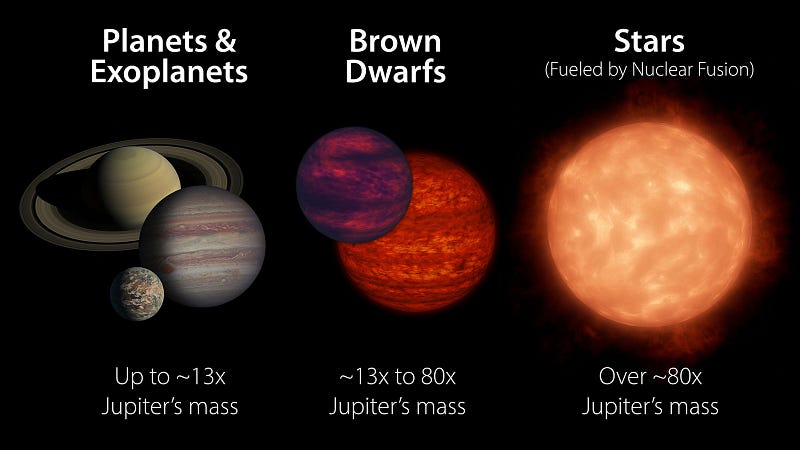Unveiling the Mysteries of Brown Dwarfs: A Cosmic Surprise
Written on
Chapter 1: Understanding Brown Dwarfs
Brown dwarfs represent a fascinating category of celestial objects — these turbulent gas giants fall between the size of a star and a planet (as illustrated below), and can exhibit extreme temperatures. Although astronomers have been aware of their existence for several years, recent findings have prompted researchers to reevaluate their theories regarding their composition and distribution within the universe.
In a surprising turn of events last year, scientists uncovered a cluster of these brown dwarfs in our local cosmic vicinity. Through a NASA-supported citizen science initiative, both volunteers and professional astronomers collaborated to identify 95 brown dwarfs. In a related discovery during 2020, a cold brown dwarf named “Elegast” was found in the constellation Hercules, approximately 212 light-years away. The revelation of these cold brown dwarfs, both near and distant, has significantly impacted astronomers' understanding.
Section 1.1: A New Discovery: “The Accident”
A recent study has brought to light another intriguing brown dwarf, referred to as WISEA J153429.75–104303.3, which has been nicknamed “The Accident.” While astronomers possess a foundational understanding of brown dwarfs, many aspects remain enigmatic. These objects are believed to form similarly to stars but lack sufficient mass to initiate nuclear fusion. The name “The Accident” stems from the serendipitous nature of its discovery, which challenges a predominant trait observed in over 2,000 known brown dwarfs in our galaxy.

“We anticipated that old brown dwarfs exist, but we also thought they would be exceedingly rare. Finding one so close to the solar system could be a mere coincidence, or it might indicate they are more prevalent than we previously believed.”
~ Federico Marocco, Lead Researcher
Section 1.2: The Age and Characteristics of “The Accident”
Initially identified by NASA’s Near-Earth Object Wide-Field Infrared Survey Explorer (NEOWISE), “The Accident” is estimated to be between 10 and 13 billion years old, which is twice the average age of known brown dwarfs. This raises the possibility that there are many more of these celestial entities than previously recognized.
A discrepancy had existed among astronomers regarding the temperature of this brown dwarf.

The search for clarity involved additional infrared observations conducted using a ground-based telescope at the W. M. Keck Observatory in Hawaii. The results revealed that the brown dwarf was so faint in those wavelengths that it could not be detected, supporting the hypothesis of its extreme coldness. Next, astronomers aimed to determine whether this dimness was due to its distance from Earth.
However, precise distance measurements from NASA’s Hubble and Spitzer Space Telescopes disproved this theory. “The Accident” appears to be located about 50 light-years from Earth and is moving at an astonishing speed of approximately half a million miles per hour (800,000 km/h). This velocity surpasses that of other known brown dwarfs within the same distance range, suggesting that it may have accelerated as it navigated past massive celestial bodies.
Chapter 2: The Composition of “The Accident”
Research indicates that the light profile of “The Accident” suggests it has minimal methane content. Methane, like all molecules, absorbs specific light wavelengths, so a methane-rich brown dwarf would appear dim in those wavelengths. In contrast, “The Accident” shines brightly, indicating low methane levels. This aligns with the characterization of it being an ancient brown dwarf that formed when the galaxy was still low in carbon, as evidenced by its current atmospheric composition.
A significant aspect of discovering more brown dwarfs may involve adjusting the methods astronomers use to locate them. One thing is clear: there is considerable diversity in the compositions of brown dwarfs throughout the universe, and further discoveries are likely. The full research findings were published in The Astrophysical Journal Letters.

Stay updated with the latest findings — Subscribe to my mailing list.